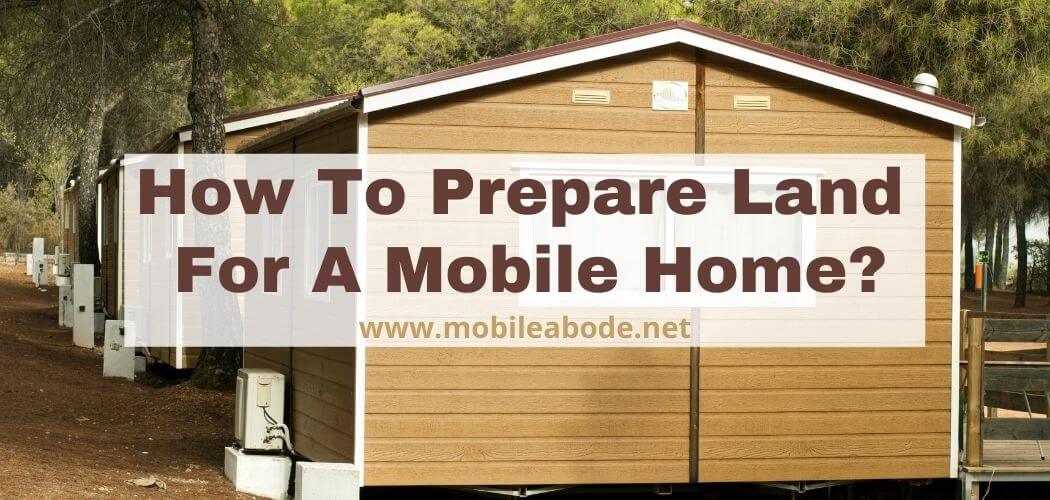The process of preparing a plot of land for a mobile home can be tedious and difficult. Although there are many different ways to prepare the land, the two most common methods are grading and compacting.
Grading is done by removing all organic material from the soil surface while compacting ensures that all loose soil particles have been pressed together so they cannot move around.
If you do not remove this organic material before laying down your foundation, it will decompose over time and create pockets in your floorboards where moisture can collect which will lead to mold growth on walls and ceilings!
It’s always a good idea to prepare the land where you are going to put your mobile home.
The steps below will help you with preparing the ground for your house.
- Place the bottom of your mobile home on blocks, bricks or cinder blocks to provide support and prevent it from sinking into soft soil.
- Dig down about 10 inches around all four sides of your foundation then dig out an additional 12 inches wide trench that is at least 24 inches deep every 20 feet along the perimeter of your property line.
- Fill in any low spots with dirt and tamp it down tightly so that water won’t collect there later on. This will ensure that rainwater doesn’t seep under your foundation and cause it to sink over time.
Also Read: How Can I Get Rid Of Dampness And Mold In My Mobile Home?
Steps to Prepare Land For Mobile Home
1. Place your mobile home and property and layout and mark the four corners with stakes or flags. Make sure to remove any large rocks, weeds, roots etc that you discover on this site visit.
2. Use a garden rake to smooth out bumps on the ground, remove any large sticks or stones then dig down about 12 inches on any area of your plot that has uneven topography.
Even if your land is flat, there are probably dips here and there so take time to smooth them out as much as possible before laying out your foundation/blocks/pads for the mobile home.
3. Rent an excavator from a construction equipment rental company to do some heavy-duty tilling on areas where your house will be placed.
You can also consider renting an industrial compacter that will help to compact the soil at a rate of 200 to 300 tons per hour.
However, if your property is large you might want to skip this step and purchase a machine that is powerful enough for your needs.
Allow time for the ground to dry out before beginning this project because wet soil will not compact properly and will not provide adequate support for your mobile home foundation.
4. Build your four concrete piers or drive down 4 steel stakes into the ground with a sledge hammer by walking around the perimeter of where you think your mobile home should be placed and marking on each stake where they intersect with another one then place them in these spots by marking points on all four of them first.
Dig out 8 inches of soil, put some gravel down in the hole, place your piers or stakes on top of them and pack the dirt tightly around each one to hold it securely in place.
5. Lay your steel framed foundation/blocks/pads down on top of these stakes/piers following the manufacturer’s specific instructions for putting together the pieces that make up your house floorplan.
Make sure that they are positioned within 2-3 inches of where you marked each one on all four sides before pouring concrete into the bottom of the holes to secure them firmly in place.
6. Fill remaining spaces between ground level and bottom of mobile home with sand or dirt so there is no gap between rocks or roots that can get into the home once you’ve finished installing it.
7. Dig a trench that is about 12-24 inches deep and 24 inches wide around the entire perimeter of your mobile home to make sure that rainwater doesn’t find its way under your foundation causing drainage problems.
Add 2 inches of crushed gravel in this trench for proper drainage before adding topsoil back from where you removed it earlier during this project.
8. Wait about 3 weeks before installing the mobile home itself then clear out any debris that has collected inside it after being delivered to your property then have it installed by a certified professional who has experience in getting this sort of work done.
9. Complete your site preparation by adding stone, concrete or asphalt to areas where vehicles are parked so they won’t sink down into the ground over time causing them to lose traction while attempting to pull out onto roads or other surfaces that might be wet during certain times of the year.
This extra step will ensure that your home is safe for everyone living inside it including pets/animals who will be using its decks, porches etc.
Also Read: How To Start A Mobile Home Park?
Final Words
Preparing land for a mobile home can be expensive and time-consuming. However, once the foundation is laid down, installing your new trailer will be much easier.
The first step is to make sure the land you are considering has a level surface.
Once your lot appears flat, pour sand into the low spots until they’re just below grade and then compact it with heavy machinery or rollers. This will provide drainage for any water that gets past your foundation before it can seep in under them and cause rot.
Your next step should be to let the ground dry out so moisture doesn’t saturate everything beneath, which could lead to mold growth on either side of your slab.
After this, you’ll need to break up large stones with dynamite if there’s anything too big for hand tools to handle; otherwise, they may crack when pressure points form during construction.
Be sure to prepare your land for a mobile home by levelling and compacting the ground before driving in stakes or pilings.
This will help you avoid costly repairs down the road, like cracking concrete foundations.

